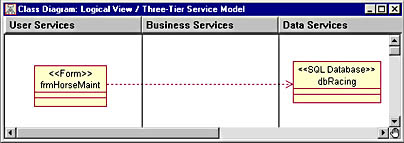Chapter 3 -- On Rules and Their Locations
Chapter 3
So that you can easily see how the architecture we've been describing works, in this chapter we'll begin looking at a very simple part of our sample horse racing application. Figure 3-1 gives you a simplified view of this small application.

Figure 3-1. The basic parts of this application are a Microsoft Visual Basic form and a database, at least in this early version.
As you can see in Figure 3-1, the only form in this sample application uses a database. We could have implemented this application as a form-based two-tier application, as in the figure, but we hope to show you, in the course of this chapter, why we decided to implement it as a multitier Microsoft Windows DNA application using our scalable architecture as a base.
For simplicity, we're not going to use stored procedures1 in the database. It's not that we don't approve of them: we refrain from using them in this example only to make the code as simple, yet realistic, as possible. Chapter 17, "Securing Good Database Performance and Scalability," includes a section on how to use stored procedures from scalable Microsoft Transaction Server (MTS) and COM+ applications. We hope that material helps you decide whether to use stored procedures in your applications.
EAN: 2147483647
Pages: 133